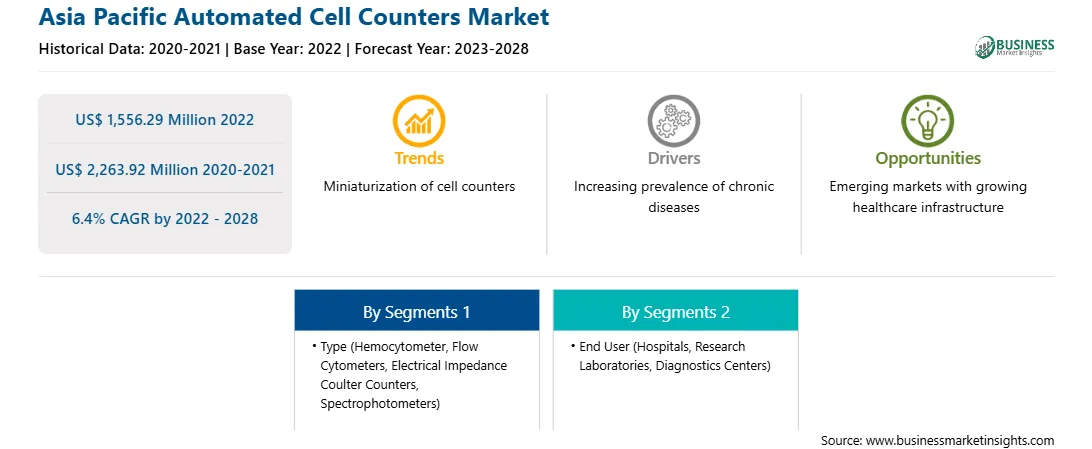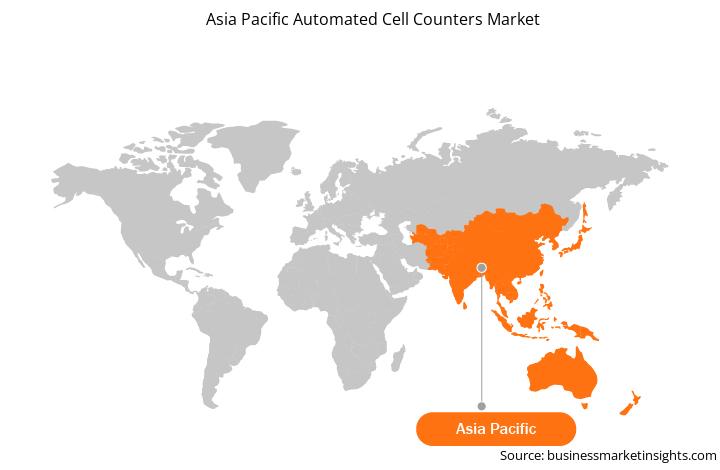The automated cell counters market in Asia Pacific is expected to grow from US$ 1,556.29 million in 2022 to US$ 2,263.92 million by 2028. It is estimated to grow at a CAGR of 6.4% from 2022 to 2028.
Frequency of infectious and chronic diseases
Chronic diseases are conditions that are present in an individual for one or more years and require ongoing medical attention. Chronic diseases are currently the major cause of death among adults in several countries of APAC. Infectious diseases are caused by infectious agents, including viruses, bacteria, parasites, fungi, and toxic products. HIV is a major public health issue across APAC. As per The Joint United Nations Programme on HIV/AIDS (UNAIDS), ~37.7 million people had HIV in 2020; out of these, 1.7 million were children aged 0–14 years, and 36 million were adults. Similarly, hepatitis is inflammation of the liver caused by a viral infection. The five primary strains of hepatitis viruses are A, B, C, D, and E. According to WHO, ~58 million people had chronic hepatitis C in 2019, and ~1.5 million new infections occur every year. As per WHO, tuberculosis (TB) is the thirteenth leading cause of death globally and the second leading infectious disease after COVID-19. Furthermore, thirty countries with high TB burdens accounted for 86% of new TB cases in 2020. Eight countries registered two-thirds of the total TB cases, with India at the forefront, followed by China, the Philippines, Indonesia, Nigeria, Pakistan, and Bangladesh. Diagnostics are essential in determining the direction of any medical treatment of infectious and chronic diseases. Cell counting is one of the methods that is used for the detection of such diseases. Therefore, the rising prevalence of infectious and chronic diseases across the APAC is driving the growth of the automated cell counters market.
Market Overview
The Asia Pacific automated cell counters market is segmented into China, Japan, India, South Korea, Australia, and the Rest of Asia Pacific. The market growth is attributed to the rising geriatric population and increasing research activities in stem cells, genomics, and proteomics. For instance, in 2018, Sysmex Corporation launched XS-500ix, an automated Hematology Analyzer, in the Chinese market. Therefore, the Chinese government has promoted policies for allocating medical resources to increase efficiency. As a result, the demand for sophisticated and high-quality products in China is likely to increase, which is expected to boost the market growth. Thus, increasing disease cases and technological development in China drive the automated cell counters market over the forecast period
Asia Pacific Automated Cell Counters
Market Revenue and Forecast to 2028 (US$ Million)
Strategic insights for the Asia Pacific Automated Cell Counters provides data-driven analysis of the industry landscape, including current trends, key players, and regional nuances. These insights offer actionable recommendations, enabling readers to differentiate themselves from competitors by identifying untapped segments or developing unique value propositions. Leveraging data analytics, these insights help industry players anticipate the market shifts, whether investors, manufacturers, or other stakeholders. A future-oriented perspective is essential, helping stakeholders anticipate market shifts and position themselves for long-term success in this dynamic region. Ultimately, effective strategic insights empower readers to make informed decisions that drive profitability and achieve their business objectives within the market. The geographic scope of the Asia Pacific Automated Cell Counters refers to the specific areas in which a business operates and competes. Understanding local distinctions, such as diverse consumer preferences (e.g., demand for specific plug types or battery backup durations), varying economic conditions, and regulatory environments, is crucial for tailoring strategies to specific markets. Businesses can expand their reach by identifying underserved areas or adapting their offerings to meet local demands. A clear market focus allows for more effective resource allocation, targeted marketing campaigns, and better positioning against local competitors, ultimately driving growth in those targeted areas.Asia Pacific Automated Cell Counters Strategic Insights

Asia Pacific Automated Cell Counters Report Scope
Report Attribute
Details
Market size in 2022
US$ 1,556.29 Million
Market Size by 2028
US$ 2,263.92 Million
Global CAGR (2022 - 2028)
6.4%
Historical Data
2020-2021
Forecast period
2023-2028
Segments Covered
By Type
By End User
Regions and Countries Covered
Asia-Pacific
Market leaders and key company profiles
Asia Pacific Automated Cell Counters Regional Insights

Asia Pacific Automated cell counters Market Segmentation
The Asia Pacific automated cell counters market is segmented on the basis of type, end user, and country. Based on type, the market is segmented into hemocytometer, flow cytometers, electrical impedance coulter counters, and spectrophotometers. The spectrophotometers segment held the largest market share in 2022. Based on end user, the market is categorized into hospitals, research laboratories, diagnostics centers, and others. The hospitals segment held the largest market share in 2022. Based on country, the market is segmented into China, India, Japan, Australia, South Korea, and the Rest of Asia Pacific. China dominated the market share in 2022.
Eppendorf; Thermo Fisher Scientific Inc.; Countstar Inc.; Bio-Rad Laboratories, Inc.; F. Hoffman-La Roche Ltd; Chemometec A/S; ALIGNED GENETICS; Beckman Coulter, Inc. (Danaher); Nanoentek; Olympus Corporation; MERCK KGaA; Sysmex Corporation; Agilent Technologies, Inc.; Abbott; and Nexcelom Bioscience LLC. are the leading companies operating in the Asia Pacific automated cell counters market.
The Asia Pacific Automated Cell Counters Market is valued at US$ 1,556.29 Million in 2022, it is projected to reach US$ 2,263.92 Million by 2028.
As per our report Asia Pacific Automated Cell Counters Market, the market size is valued at US$ 1,556.29 Million in 2022, projecting it to reach US$ 2,263.92 Million by 2028. This translates to a CAGR of approximately 6.4% during the forecast period.
The Asia Pacific Automated Cell Counters Market report typically cover these key segments-
The historic period, base year, and forecast period can vary slightly depending on the specific market research report. However, for the Asia Pacific Automated Cell Counters Market report:
The Asia Pacific Automated Cell Counters Market is populated by several key players, each contributing to its growth and innovation. Some of the major players include:
The Asia Pacific Automated Cell Counters Market report is valuable for diverse stakeholders, including:
Essentially, anyone involved in or considering involvement in the Asia Pacific Automated Cell Counters Market value chain can benefit from the information contained in a comprehensive market report.